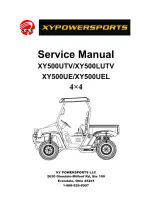
57
OPERATION
Hauling Cargo
Overloading the vehicle or carrying or towing cargo improperly
can alter vehicle handling and may cause loss of control or
brake instability. Always follow these precautions when hauling
cargo:
S
Never exceed the stated load capacity for this vehicle.
S
Reduce speed and allow a greater distance for braking.
S
When operating over rough or hilly terrain, reduce speed
and
cargo
to maintain stable driving conditions.
S
WEIGHT DISTRIBUTION in the cargo bed should be as far
forward and as low as possible. Carrying a high load raises
the center of gravity and creates a less stable operating con-
dition. Reduce load weight when cargo is high. When han-
dling off-centered loads that cannot be centered, secure the
load and operate with extra caution.
S
ALL LOADS MUST BE SECURED BEFORE OPERATING.
Unsecured loads may shift and create unstable operating
conditions, which could result in loss of control of the vehicle.
Always be sure that the cargo bed is lowered and latched be-
fore moving the vehicle.
S
EXTREME CAUTION MUST BE USED when operating with
loads extending beyond the rack or cargo bed. Stability and
maneuverability may be adversely affected, causing the ma-
chine to overturn.
S
Carrying a load on only the front rack or cargo bed may cause
an imbalanced condition and increases the possibility of ve-
hicle overturn. Balance loads proportionally between the front
rack and cargo bed, but do not exceed the stated load capac-
ity.
S
Use extreme caution when applying brakes with a loaded ve-
hicle. Avoid terrain or situations that may require backing
downhill.
S
Always attach the tow load to the hitch point.
S
The vehicle should never exceed 10 mph (16 kph) while tow-
ing a load on a level surface. Vehicle speed should never ex-
ceed 5 mph (8 kph) when towing loads in rough terrain, while
cornering, or while ascending or descending a hill.
S
Do not obstruct the headlight when loading the front rack.
WARNING
















































